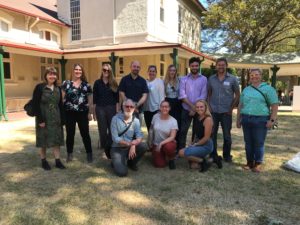
On Friday 1st February 2019, archaeologists from Dr Vincent Clark & Associates presented the results of their work at the Victorian Archaeology Colloquium which was held at La Trobe University. The Colloquium is an annual event for archaeologists and Traditional Owners in Victoria to share ideas and present their work.
The event was well attended and prompted interesting discussion about the way archaeology is conducted in Victoria. The day began with a ‘Welcome to Country’ smoking ceremony conducted by Wurundjeri Woi-wurrung Cultural Heritage Aboriginal Corporation Elder, Perry Wandin with the presentations following.
Both of the Dr VC&A presentations focussed on the excavation of Jones Lane, part of the Wesley Church Complex (Wesley Place development project) that was excavated in 2017.
Michelle presented on behalf of herself and her co-authors (Jasmine Scibilia and Nadia Bajzelj) and discussed their interpretation of the clay deposits at Jones Lane. They noted that when conducting excavations in Melbourne’s CBD, below a substantial clay fill layer were the remains of the earliest European occupation of this part of Melbourne, dating back to the 1840s.
In the 1850s the Melbourne City Council built up the level of the streets to help to manage the chronic flooding that occurred in the city centre. This often left private residences well below the raised street level and the owners of these buildings were often left to deal with the consequential water damage to their property themselves.
The properties were eventually filled in with clay and other structures were erected on top of them. While this may not have been such a good situation for mid-19th century homeowners, it is fantastic for 21st century archaeologists. Much of what lies beneath the introduced clay fill is very early archaeological material in well preserved and secure contexts.
Nadia and Chris presented their findings on Residence 7 and 10 Jones Lane. Both these houses turned out to be a little more interesting than the others – the combination of artefacts and historical records indicate that these residences were a brothel and sly grog shop respectively. The quantity of bottles and oyster shells along with the types of jewellery and personal effects lent weight to this theory. Police records from the period recount officers staking out Residence 10 to catch the illegal trade.
These were only two of a number of fascinating presentations. The whole Dr VC&A team are looking forward to next year’s colloquium and are eagerly awaiting hearing about the contributions to Victorian archaeology.
